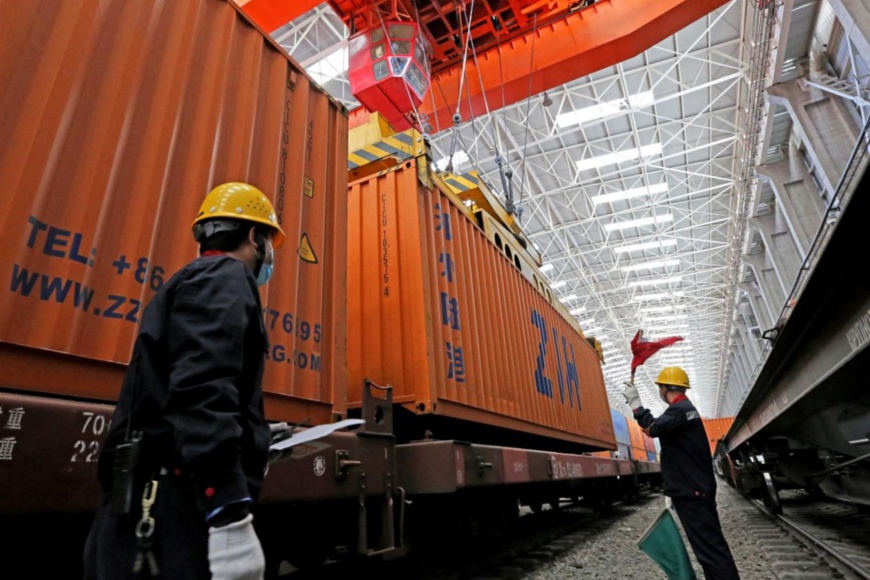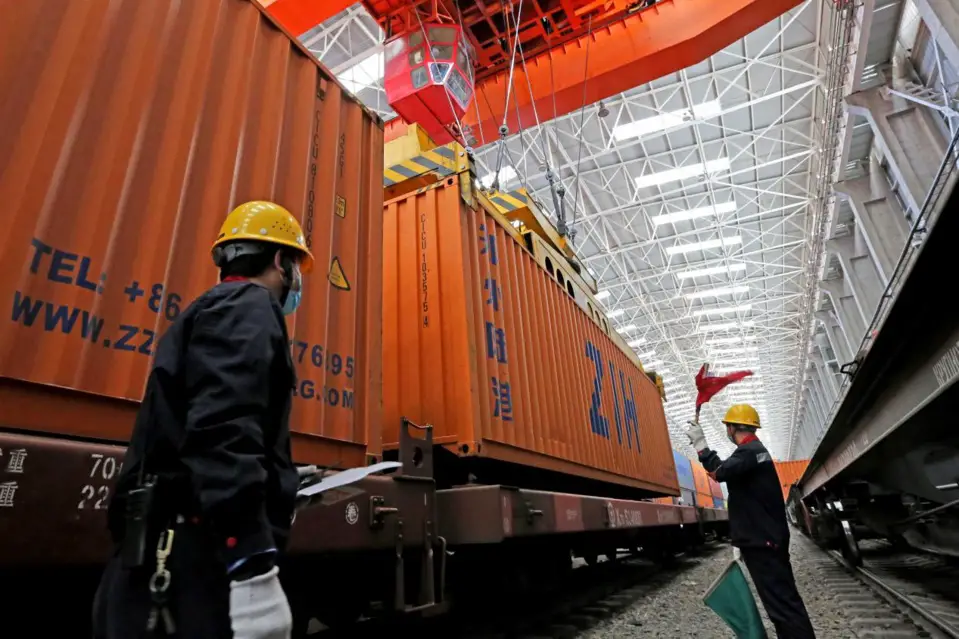By Li Yanan, People’s Daily

Photo taken on Sept. 29, 2020, shows staff members reloading containers at a railway reloading warehouse at Alashankou port, Bortala Mongol autonomous prefecture, northwest China’s Xinjiang Uygur autonomous region. (Photo by Cai Zengle/People’s Daily Online)
Last year, Alashankou port, northwest China’s Xinjiang Uygur Autonomous Region, cleared 15 million tons of import and export cargos, up 12 percent from the previous year. The port witnessed a total of 5,027 inbound and outbound China-Europe (Central Asia) freight train trips in 2020, a year-on-year increase of 40.1 percent.
The surge in business didn’t slow down the clearance of cargos at the port, as it has taken multiple measures to improve efficiency and guarantee freight trains loaded with goods pass through the port smoothly.
On July 1, 2020, the Alashankou port adopted a digital system that allows information about cargos on China-Europe (Central Asia) freight trains to be input into the system at their departure stations.
Thanks to the system, Dou Shanshan, a staff member of the Alashankou port, no longer needs to manually input information about the cargos before releasing the freight trains and could simply verify relevant information already recorded in the system, thus greatly saving the time of clearance.
“In the past, we could only permit through seven or eight trains a day at most, while now at least ten trains pass through the port per day, with the number reaching 14 or 15 during the peak periods, ” Dou noted.
After she finished checking information about the goods via the system, Dou would send a message to freight forwarders, informing them that the goods they declared are ready to be cleared.
Freight forwarders then send one person to collate documents for the clearance of cargos at the railway international intermodal transport building of Alashankou port when they had to send several people for the procedures in the past, according to Dou.
Although more trains are cleared at the port, less people are seen waiting in queues at the hall of the railway international intermodal transport building of Alashankou port, Dou noted.
“Our export volume has increased, and yet it takes less time to pass through customs. The job that used to take three or four people over an hour can now be finished by me alone in less than 10 minutes,” said Zhang Qian, an employee of an international freight forwarder in Xinjiang.
“I can now handle customs clearance procedures for at least two trains a day,” Zhang added.
In 2020, Dou alone handled 34,604 waybills. Outbound freight trains have kept running during the epidemic prevention and control period, according to Dou, who disclosed that she has seen as many as four trains arrive at the port at the same time.
“I feel so proud that so many goods are checked by me and then transported to various areas around the world every day. In particular, when we were faced with COVID-19 outbreak at home, we were still able to send large amounts of cargos, including articles of daily use, electronic equipment, and anti-epidemic supplies, to foreign countries, which gave me great sense of achievement,” Dou noted.
To minimize the time China-Europe (Central Asia) freight trains have to stay at the port, Alashankou port has also set up a dedicated window for China-Europe (Central Asia) freight trains, giving priority to them in inspection and clearance and offering 24/7 services to these trains.
“We have truly provided year-round services,” said Arikemujiang Keranmu, a staff member of the customs at Alashankou port, explaining that if they don’t work at night, they will still have to clear the backlog of work the next day.
All the personnel working at the port have been trying to reduce the time trains need to stay at the port, Keranmu said, adding that basically all the procedures freight trains need to go through at the port, including formalities at the customs, railway department, as well as border inspection station, can now be finished in less than twenty hours.
The Alashankou port launched cross-border e-commerce business on Jan. 21, 2020, and has since seen explosive growth in the number of cross-border e-commerce export packages, with the daily number of export packages exceeding 12,500 pieces and the annual figure in 2020 reaching 38.4 million.
“There is a very high demand for our goods in foreign countries. We handled 1 million export orders in the first six days of 2021. The total number of export orders is expected to reach 50 million this year,” said Zhang Xiaodong, a customs officer at Alashankou port.
E-commerce packages have high requirement for timely delivery, Zhang said, stressing that they will try to provide better services so as to meet the demand of China-Europe (Central Asia) freight trains for all-weather customs clearance.
The surge in business didn’t slow down the clearance of cargos at the port, as it has taken multiple measures to improve efficiency and guarantee freight trains loaded with goods pass through the port smoothly.
On July 1, 2020, the Alashankou port adopted a digital system that allows information about cargos on China-Europe (Central Asia) freight trains to be input into the system at their departure stations.
Thanks to the system, Dou Shanshan, a staff member of the Alashankou port, no longer needs to manually input information about the cargos before releasing the freight trains and could simply verify relevant information already recorded in the system, thus greatly saving the time of clearance.
“In the past, we could only permit through seven or eight trains a day at most, while now at least ten trains pass through the port per day, with the number reaching 14 or 15 during the peak periods, ” Dou noted.
After she finished checking information about the goods via the system, Dou would send a message to freight forwarders, informing them that the goods they declared are ready to be cleared.
Freight forwarders then send one person to collate documents for the clearance of cargos at the railway international intermodal transport building of Alashankou port when they had to send several people for the procedures in the past, according to Dou.
Although more trains are cleared at the port, less people are seen waiting in queues at the hall of the railway international intermodal transport building of Alashankou port, Dou noted.
“Our export volume has increased, and yet it takes less time to pass through customs. The job that used to take three or four people over an hour can now be finished by me alone in less than 10 minutes,” said Zhang Qian, an employee of an international freight forwarder in Xinjiang.
“I can now handle customs clearance procedures for at least two trains a day,” Zhang added.
In 2020, Dou alone handled 34,604 waybills. Outbound freight trains have kept running during the epidemic prevention and control period, according to Dou, who disclosed that she has seen as many as four trains arrive at the port at the same time.
“I feel so proud that so many goods are checked by me and then transported to various areas around the world every day. In particular, when we were faced with COVID-19 outbreak at home, we were still able to send large amounts of cargos, including articles of daily use, electronic equipment, and anti-epidemic supplies, to foreign countries, which gave me great sense of achievement,” Dou noted.
To minimize the time China-Europe (Central Asia) freight trains have to stay at the port, Alashankou port has also set up a dedicated window for China-Europe (Central Asia) freight trains, giving priority to them in inspection and clearance and offering 24/7 services to these trains.
“We have truly provided year-round services,” said Arikemujiang Keranmu, a staff member of the customs at Alashankou port, explaining that if they don’t work at night, they will still have to clear the backlog of work the next day.
All the personnel working at the port have been trying to reduce the time trains need to stay at the port, Keranmu said, adding that basically all the procedures freight trains need to go through at the port, including formalities at the customs, railway department, as well as border inspection station, can now be finished in less than twenty hours.
The Alashankou port launched cross-border e-commerce business on Jan. 21, 2020, and has since seen explosive growth in the number of cross-border e-commerce export packages, with the daily number of export packages exceeding 12,500 pieces and the annual figure in 2020 reaching 38.4 million.
“There is a very high demand for our goods in foreign countries. We handled 1 million export orders in the first six days of 2021. The total number of export orders is expected to reach 50 million this year,” said Zhang Xiaodong, a customs officer at Alashankou port.
E-commerce packages have high requirement for timely delivery, Zhang said, stressing that they will try to provide better services so as to meet the demand of China-Europe (Central Asia) freight trains for all-weather customs clearance.
 Menu
Menu
 Alashankou port in NW China’s Xinjiang explores digital system, improves clearance efficiency
Alashankou port in NW China’s Xinjiang explores digital system, improves clearance efficiency
















